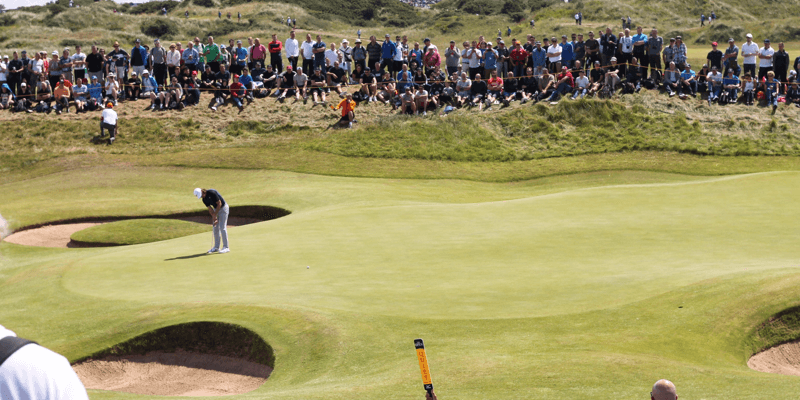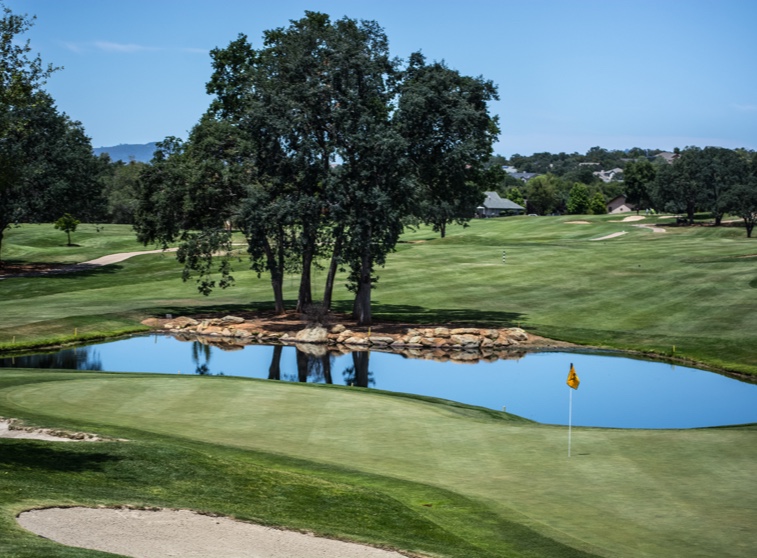One of the great things about golf is that it can be enjoyed by all ages and skill levels. If you are a beginner, you may have heard of the term green being used while out on the golf course. The green is an important area on the golf course and is one that every golfer should be familiar with.
The green in golf is the area on a golf course where the flagstick and hole are located. Golf greens are the most closely mowed, smoothest and delicate areas of grass on the course. When golfers reach the green successfully they will use their putters to roll the ball into the hole.
Golf greens can come in a variety of shapes and sizes and each hole will have a unique green. Every golfer’s objective is to be able to reach the green in as few shots as possible, in hopes they can make their puts and receive a low score for the hole.
In this article we will discuss the golf green more in-depth as well as talk about the different
elements that make up a golf course, why they are important, and what role they play.
Golf Green

When most people talk about the green in golf they are referring to the putting green. This is the part of the hole that is cut much shorter and is specially prepared for putting.
The green is essentially the area around each hole that is typically around 5,160-6,450 sq. ft. that has an incredibly smooth surface and has the grass mown down.
This green is where your ball will roll easily over the ground and is where you’ll use your putter to put or in other words roll your ball into the hole.
The area surrounding the green is called the fringe. The fringe helps connect the fairway and rough to the green and provides a smooth transition as your ball roles to the green.
For more information and to read the specific rules around the putting green check out this article.
Although the green is perhaps the most popular zone in golf, there are other areas that are as equally important as well. Let’s discuss each of these.
Makeup of a Golf Course
Most golf courses are made up of 18 holes. These series of holes each consist of a teeing ground, a fairway, the rough and some potential hazards, as well as a green where the hole and flag are located.
It’s important for every golfer to be able to identify and understand these areas of the golf course to ensure they follow the rules and learn how to properly play.
Let’s discuss each one of these areas in detail to help you better understand how golf courses are designed and how the game of golf is played.
Golf Course Components
- Teeing Ground
- Fairway
- Rough
- Hazards
- Green
Teeing Ground
The first area on a golf course is what is called the teeing ground. The teeing area is where each player begins the hole and has a defined size and shape.
The teeing area is a rectangle shape that is typically two club-lengths deep. This area is marked off by tee-markers and golfers must hit the ball within this area.
Most courses have different teeing ground areas based on the skill-level of the player. More advanced golfers teeing ground is set further back while the beginner or youth teeing grounds are typically closer the hole.
For more information and specific rules about the teeing ground, check out this resource from USGA.org for additional information.
Fairway
The second area of the golf course is what is called the fairway. The fairway is section of nicely mowed grass that is between the tee and the green.
Fairways are considered the ideal landing area for shots of the tee and provides the golfer a pathway to the green. This is where you want to have your ball land after you tee off.
The closely mown fairways make it easier to strike the ball cleanly when compared to the rough where the grass is much longer and harder to hit from.
Fairways are always apart of par-4 and par-5 holes, but the might not be included in certain par-3’s due to the proximity of the hole from the tee box.
Rough
Another important area of the golf course is what is called the rough. The rough is the longer-cut area of grass that surrounds the fairway and green.
The longer grass makes hitting the ball cleanly more difficult, so it’s best to avoid the rough if possible. Hitting from the rough typically means you hit a poor shot and will often mean your further away from the green.
Players hitting form the rough will often use more club than they normally would to be able to get distance out of the thicker grass.
Hazards
An area of the golf course that all golfers hope to avoid are the hazards. There are two types of golf hazards: bunkers and water.
Bunkers also known as sand traps are holes in the ground filled with sand and typically line the edge of the fairway or surround the green.
The combination of sand and it being a hole makes hitting your golf out of bunkers challenging and requires a sand wedge and a lot of practice to get good at.
Water hazards such as lakes, rivers, ponds, creeks and sometime the ocean can perhaps be more challenging to avoid. If your ball does fall into the water, you’ll have to take a stroke penalty.
While playing a hole it’s important to be able to identify where the hazards are located so you can do your best to avoid them. This will make your life a lot easier.
Green
The green is the area on the golf course that holds the hole and flagstick. This area is the shortest cut and best maintained grass of the entire course.
The short grass allows the ball to roll easily making it ideal for putting. Reading the greens and making your puts is one of the most important aspects of golf and is one all golfers strive to master.
The area that directly surrounds the green is called the fringe and has slightly longer grass. Providing a smooth transition from the rough and fairway to the green.
For more information about the different parts of a golf course check out this article by Golf Week.
Final Thoughts
As we discussed in this article the green is one of the most important areas on the golf course and is where the hole and flagstick is located.
However, there are also other important areas of the course that are important to be familiar with as well. Such as the teeing ground, fairway, the rough and potential hazards.
I hope this article has helped you learn about these different components and gives you a solid foundation of what you should expect when you hit the course for a round.
Also, remember If your ball hits the green hard and creates a divot, make sure to fix it to ensure the green stays well maintained and your divot doesn’t disrupt the next golfer.

